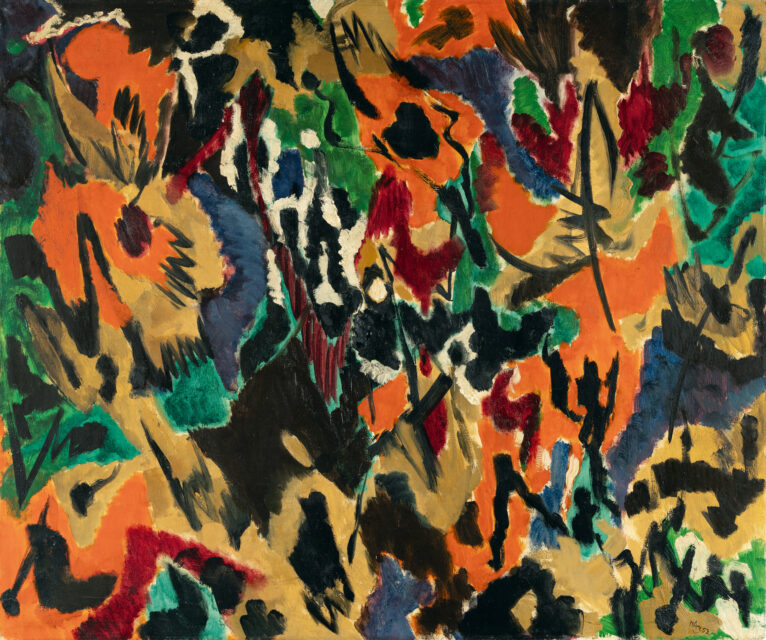Orange mercurial
Details
With various inscriptions and customs stamps on the reverse on the stretcher. Scheibler 603. Literature: Haftmann, Werner, E. W. Nay, Cologne 1991 (extended new edition), p. 162, not ill.Exhibitions:E. W. Nay, Galerie Günther Franke, Munich 1952, cat. no.5, not ill.;Ausstellung Georg Meistermann, E. W. Nay, Hans Uhlmann, Galerie Ferdinand Möller, Cologne 1952, cat. no.13;E. W. Nay, Kunstverein, Hamburg 1955;E. W. Nay, Kunstverein für die Rhinelande und Westfalen, Düsseldorf 1959, cat. no.78, not ill; Works from San Diego Collections, La Jolla Museum of Art, La Jolla/Kalifornien 1965; Retrospektive E. W. Nay, Museum Ludwig/Josef-Haubrich-Kunsthalle, Cologne et. al. 1990/91, cat. no.51, with black and white ill. p. 113;E. W. Nay. Retrospektive, Hamburger Kunsthalle, Hamburg et. al. 2022/23, cat. no.48, with col. illus. p. 176. Provenance: Galerie Günther Franke, Munich, 1959; Dalzell Hatfield Galleries, lot Angeles;private ownership, San Diego;Hauswedell & Nolte, Hamburg 10.6.1986, lot 908, col. plate 47 (“Abstrakte Improvisation”);private ownership;Christie’s, London 8.10.1998, lot 214, col. plate p. 273; private collection, Hamburg.
Descrizione
• From the important “Rhythmic Images” series
• Dynamic, energetic and colourful composition
• The work was shown at the Nay retrospective exhibitions in 1990/91 and 2022/23 “In all of these, one voice sings wonderfully alone: E. W. Nay.
Nothing short of musical cantilenas in pure colour, that do not seek to reflect a visual experience or define a form. From the masterful tuning of his instrument of colour rises an Orphic song that leaves words and content far behind it and paints only the joy of a fulfilling hour (…).” (Werner Haftmann, in: FAZ, May 23, 1953). The painting “Orange Merkurisch” comes from the series of “Rhythmic Images” that Nay painted in 1952 and 1953. The composition formed from numerous, rather dark shades and rhythmically placed black lines that almost allow the eponymous orange surfaces to glow. The new dynamism and freshness that emanates from these “Rhythmic Images” stands in clear contrast to Nay’s previous works. Even paintings created as recently as 1951 appeared static, almost sedate, in comparison to these works, despite their vivid colours. The change is particularly obvious in the lines between the colour fields, which are no longer clearly defined. Their contours remain largely open and form numerous frayed points and spikes. The parallels to the woodcut technique, which Nay was familiar with and whose characteristics he transfered to the medium of painting, are clearly visible. The changes in Nay’s painting were closely linked to his personal life and concrete experiences. In the autumn of 1951, the artist moved from Hofheim am Taunus to Cologne and discovered an extremely inspiring and optimistic atmosphere in the Rhenish metropolis, which was still heavily marked by damage from the war. Nay attended numerous concerts and, in addition to the classics of modern music – Schönberg, Webern, Bartok, Stravinsky and Hindemith – also got to know the musical avant-garde and jazz. At that time, Cologne was becoming the centre of “New Music” with composers and musicians such as Karlheinz Stockhausen, Herbert Meilet, Pierre Boulez and Luigi Nono. Musical history was being written in the “Studio for Electronic Music” founded by WDR in 1951. Nay frequented this artistically fertile environment and was greatly inspired by the music he heard there. During that time was when Nay achieved his decisive artistic breakthrough and found recognition not only in Germany but also internationally. His first trips to nearby European countries confirmed Nay in his artistic path and “opened his eyes to a new European culture that was developing after the war” (Elisabeth Nay-Scheibler, in: WVZ Vol. II, p. 6). In 1955, Nay had his first solo exhibition in the USA at the Kleemann Galleries in New York. In the same year he took part in the first documenta in Kassel. In 1956, he was commissioned to design the German pavilion at the Venice Biennale. The painting “Orange Merkurisch” was exhibited at the international Nay retrospective in Cologne, Basel and Edinburgh in 1990/91 and was part of the exhibition in Hamburg, Wiesbaden and Duisburg that just ended at the beginning of August (2022/23).
* Tutte le informazioni includono la commissione a carico dell'acquirente (27%) senza IVA e senza garanzia. Salvo errori.
** Tutte le informazioni più la commissione a carico dell'acquirente e l'IVA e senza garanzia. Salvo errori.
*** Con riserva: L'offerta è stata accettata al di sotto del limite. L'acquisizione dell'opera potrebbe essere ancora possibile nella nostra vendita post-asta.
R = Le opere d'arte regolarmente tassate
N = Opere d'arte soggette a tassazione differenziata e provenienti da un paese non UE
Non è consentita la riproduzione e la distribuzione privata o commerciale di tutte le illustrazioni delle opere esposte nell'archivio della mostra e dell'asta. Tutti i diritti riservati.


